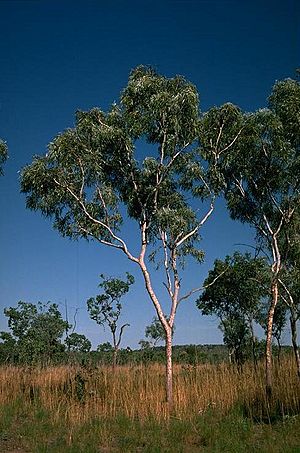Silver-leaved bloodwood facts for kids
Quick facts for kids Silver-leaved bloodwood |
|
|---|---|
 |
|
| Corymbia collina near Mount House | |
| Scientific classification | |
| Genus: |
Corymbia
|
| Species: |
collina
|
The silver-leaved bloodwood (scientific name: Corymbia collina) is a special type of tree. It grows only in Western Australia. This tree has rough, patchy bark on its trunk. Higher up, its bark is smooth and light-colored. It has long, curved leaves. Its flowers are creamy white and grow in groups. After flowering, it produces barrel-shaped fruits.
What it Looks Like
The silver-leaved bloodwood tree usually grows to be about 7 to 18 meters tall. That's like a building with two to six floors! It has a special woody swelling at its base called a lignotuber. This helps the tree regrow if it gets damaged.
Its bark is rough and patchy on the lower part of the trunk. It feels fibrous or flaky. Higher up, the bark is smooth and can be white, cream, or light grey.
Leaves and Flowers
Young plants have heart-shaped or egg-shaped leaves. These leaves are about 5.5 to 13 centimeters long. They are also 4 to 7 centimeters wide.
Adult leaves are shiny green and shaped like a spear. They are usually 9.2 to 23.5 centimeters long. They are also 1 to 3 centimeters wide. These leaves have a stalk called a petiole that is 1 to 3.7 centimeters long.
The tree's flower buds grow at the ends of its branches. They are on a stalk called a peduncle, which is 0.5 to 3.5 centimeters long. Each part of this stalk holds seven buds. These buds are on smaller stalks called pedicels, which are 0.5 to 2.8 centimeters long.
The mature buds are oval-shaped. They are about 1.3 to 1.6 centimeters long and 1 to 1.1 centimeters wide. They have a rounded cap called an operculum. The tree blooms from April to June. Its flowers are a creamy white color.
Fruit
After the flowers, the tree produces a woody fruit. This fruit is shaped like a barrel. It is about 2.6 to 3.7 centimeters long. It is also 1.8 to 2.5 centimeters wide. The parts that open to release seeds are hidden inside the fruit.
How it Got its Name
The name Eucalyptus collina was first seen in a newspaper in Western Australia. This was on June 2, 1906. It was in an article written by William Vincent Fitzgerald.
The first official description of this tree was published in 1923. This was done by Joseph Maiden in his book about Eucalyptus trees. He used Fitzgerald's notes.
Later, in 1995, two scientists named Ken Hill and Lawrie Johnson changed the tree's name. They renamed it Corymbia collina.
Where it Lives
The silver-leaved bloodwood tree grows in Western Australia. You can find it in rocky areas. It lives on tablelands and slopes. It is found in places like the Wunaamin Miliwundi Ranges and the Bungle Bungle Range. These areas are in the Kimberley region.

